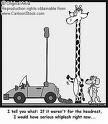Dr. Brian Stemper, Ph.D., a biomedical engineer at the Medical College of Wisconsin has studied whiplash injuries for over 10 years. He is researching ways to improve the risks associated with whiplash by working directly with car maker to reduce injuries associated with rear end collisions. Dr. Stemper states that the top of
your head restraint should be about even with the top of your head or as high as
you can get it, depending on how tall you are. Ideally, you should have the head
restraint as close to the back of your head as possible.

"You want to set your head restraints so that it's very close to the back of your head," he explained. "Each time drivers and passengers get in a car, they should be sure the head restraint is correctly positioned to minimize injuries."
Dr. Stemper created a mathematical computer model of the head and neck and studied it using simulated rear-end collisions. The computer response was examined in 57 different measures of realistic spinal motion. The model can be used to determine quantifiable data on soft tissue distortions in humans. As Dr. Stemper explains, the model shows that "auto head restraints positioned less than 2.4 inches from the back of the head kept ligament stretch within the physiologic range." Simply going by these guidelines, many acceleration- deceleration (whiplash type accidents) can be could be prevented. It is when the restraint distance goes beyond 2.4 inches that whiplash occurs.
Head rest position is crucial, because when the head rest is too low and far back, injury is more likely to occur.

By placing the rest level with the top of your head and two inches or less from the back of it, head movement is reduced and whiplash prevented.
Next time you get in your car, check the position of your headrest, and don't forget your seatbelt either !

Read more about Whiplash in our Special Whiplash series:
Part 1: Can whiplash cause shoulder pain?
Part 2: How does Whiplash Occur?
Part 3: What Symptoms are associated with a whiplash type injury
Visit us on the web at Arc4life.com
No comments:
Post a Comment